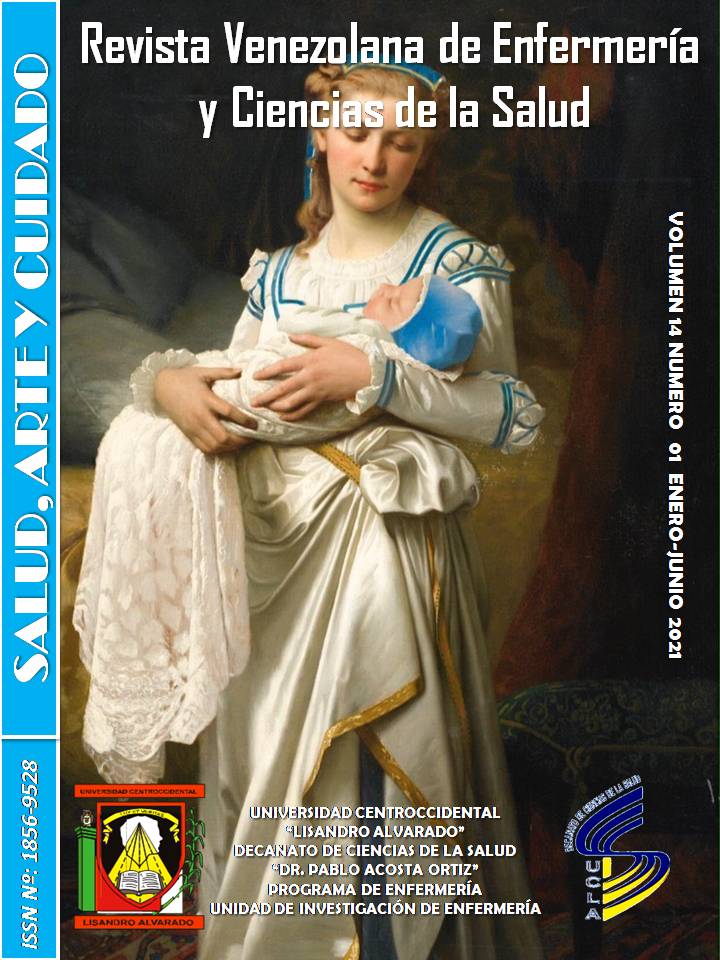Clinical and epidemiological characteristics of neonatal sepsis multipurpose Intensive Care Unit
DOI:
https://doi.org/10.5281/zenodo.6969295Keywords:
neonatal sepsis, nursing, clinical epidemiologyAbstract
The present study aims to analyze the clinical and epidemiological characteristics of neonatal sepsis Polyvalent Intensive Care Unit, AgustínZubillaga Pediatric University Hospital, Barquisimeto, Lara State. Regarding the research methodology, it presents a quantitative, descriptive, non-experimental, cross-sectional and retrospective approach, in which newborns between 0 to 28 days old who present the diagnosis were taken as the histories of the population. of neonatal sepsis, the results found in the histories of the clinical characteristics of neonatal sepsis, the transmission mechanism was 84% vertical, 16% nosocomial, the time of presentation 84% early and 16% late, a blood culture was performed at 86 % and only 14% were positive and 71% isolated gram negative bacteria and 29% gram positive, the germs isolated in the cultures are gram negative bacteria and those with the highest incidence where 7% were for Echericha coli and another 7% were for Klebsiellapneumoniae, positive reports for 0% beta group streptococci. Complications of sepsis presented by the patients were; respiratory distress 100%, vomiting 27%, seizures 58% and hypotonia 53%. Patients presented signs of sepsis 51% reticulated skin, 26% slow capillary filling, 21% irritability, 47% abdominal distention, 9% hepatomegaly, 35% apnea , 21% tense fontanelle, 58% jaundice, 49% hypothermia, 53% hypotonia, 86% skin paleness, 19% weak pulses, and 51% cyanosis. The epidemiological characteristics highlight the neonatal data: female 56%, male 44%, with a preterm gestational age 53% at term 44% and post-term 3%, while the maternal data the maternal age was comprised of 12 to 19 years 23%, from 20 to 35 years old and 67% and over 35 years old 9%. The conclusions were that sepsis with clinical complications such as respiratory distress, vomiting, seizures and hypotonia continues to be a frequent pathology in neonatology with a significant percentage of morbidity and mortality.
Downloads
References
Villegas E. (2008) Mecanismo de la infección. Microbiología unidad III Tema 5. Disponible en http://webdelprofesor.ula.ve/nucleotrujillo/elciv/clases_microbiologia/unidad_3.pdf
García, M. (2007). La Inmunidad. El Sistema Biológico de la Defensa. Guía en Línea: http://www.educa.jcyl.es/educacyl/cm/gallery/recursos_jcyl/am/6_1inmunidad/archivos/ayuda_alumno.pdf
Cisterna R. (2007) Microbiología. Art en línea: https://www.masdermatologia.com/PDF/0006.pdf
Singer, M. (2016) Deutschman CS, Seymour CW, Shankar-Hari M, Annane D, Bauer M, et al. The Third International Consensus Definitions for Sepsis and Septic Shock (Sepsis-3). JAMA. 2016;315(8):801-1
Coronell, W. (2009). Sepsis neonatal. Art de revisión: https://www.medigraphic.com/pdfs/revenfinfped/eip-2009/eip094f.pdf
Teran, V. (2016) Características clínicas y epidemiológicas de la sepsis neonatal tardía por Staphylococcus coagulasa negativo en el Hospital Nacional Edgardo Rebagliati Martins en el año 2016. Disponible en: https://cybertesis.unmsm.edu.pe/handle/20.500.12672/7618.
Marrufo, S. (2016) Características clínicas y epidemiológicas de recién nacidos con sepsis neonatal y bajo peso al nacer en el servicio de neonatología del Hospital Regional Docente Las Mercedes en el año 2016. Disponible en: http://repositorio.unprg.edu.pe/handle/UNPRG/3677
MurguíaT., Vázquez E. (2006) El recién nacido de muy bajo peso. Bol. Med. Hosp. Infant. Mex. [Online]. 2006, vol.63, n.1, pp.4-7. ISSN 1665-1146.
Lorenz JM. (2002). Fluid and electorlyte therapy in the niwborn infant. In: Burg FD, Polin RA, Ingelfinger JR, Gershon A, eds. Current Pediatric Therapy 17. Philadelphia, Pa:WBSaunders; 2002.
Buelvas J. y Mulford N. (2016). Sepsisneonatal: análisis en el recién nacido de madres con infección urinaria. Consultado: http://saber.ucv.ve/bitstream/123456789/16133/1/T026800016874-0-Buelvas_Jean_Carlos_Mulford_Nazly_final_publicacion-000.pdf.
Echeverría, J. (2019). Características Clínicas y Epidemiológicas de la Sepsis Neonatal en un Hospital Pediátrico. Universidad Ciencia Y Tecnologias, 1(1), 6. Recuperado a partir de https://www.uctunexpo.autanabooks.com/index.php/uct/article/view/197.
Arosemena Viteri, E. M. (2019). Tesis. Recuperado a partir de http://repositorio.ug.edu.ec/handle/redug/43110
Pérez, P. (2018).Características clínicas y paraclínicos de recién nacidos con sepsis en un hospital Nivel IV en Cali, Colombia. Infect. [Online]. 2018, vol.22, n.3, pp.141-146. ISSN 0123-9392. http://dx.doi.org/10.22354/in.v22i3.725.
Licona, T. (2016) Características epidemiológicas y clínicas de neonatos con sepsis temprana / Clinical and epidemiologicalcharacteristicsinnewbornswithearlysepsis. Int. j. med. Surg. Sci. (Print); 3(3): 903-908, sept. 2016. graf, tab ArtigoemEspanhol | LILACS | ID: biblio-1087454
Llacta J. (2019). Característicasclínicas, microbiológicas y terapéuticas de la sepsis neonatal confirmada en el Hospital Nacional Adolfo Guevara Velasco, 2016 – 2018. http://repositorio.unsaac.edu.pe/handle/20.500.12918/4577
Hernández I. (2016) Caracterización clínico epidemiológicas de recién nacidos admitidos por sepsis temprana. Western Regional Hospital, Belice, 2015. Mul Med. 2016;20(4):771-783
Published
How to Cite
Issue
Section

This work is licensed under a Creative Commons Attribution-NonCommercial-ShareAlike 4.0 International License.
Derechos del/de autor/es a partir del año de publicación
Esta obra está bajo la licencia:
Creative Commons Reconocimiento-NoComercial-CompartirIgual 4.0 Internacional (CC BY-NC-SA 4.0)
Las opiniones expresadas por los autores no necesariamente reflejan la postura del editor de la publicación ni de la UCLA. Se autoriza la reproducción total o parcial de los textos aquí publicados, siempre y cuando se cite la fuente completa y la dirección electrónica de esta revista. Los autores(as) tienen el derecho de utilizar sus artículos para cualquier propósito siempre y cuando se realice sin fines de lucro. Los autores(as) pueden publicar en internet o cualquier otro medio la versión final aprobada de su trabajo, luego que esta ha sido publicada en esta revista.







